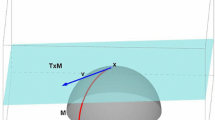Abstract
In this paper, we propose a novel method called dynamic transition embedding (DTE) for linear dimensionality reduction. Differing from the recently proposed manifold learning-based methods, DTE introduces the dynamic transition information into the objective function by characterizing the Markov transition processes of the data set in time t(t > 0). In the DTE framework, running the Markov chain forward in time, or equivalently, taking the larger powers of Markov transition matrices integrates the local geometry and, therefore, reveals relevant geometric structures of the data set at different timescales. Since the Markov transition matrices defined by the connectivity on a graph contain the intrinsic geometry information of the data points, the elements of the Markov transition matrices can be viewed as the probabilities or the similarities between two points. Thus, minimizing the errors of the probability reconstruction or similarity reconstruction instead of the least-square reconstruction in the well-known manifold learning algorithms will obtain the optimal linear projections with respect to preserving the intrinsic Markov processes of the data set. Comprehensive comparisons and extensive experiments show that DTE achieves higher recognition rates than some well-known linear dimensionality reduction techniques.








Similar content being viewed by others
Explore related subjects
Discover the latest articles, news and stories from top researchers in related subjects.References
Jain AK, Duin RPW, Mao J (2000) Statistical pattern recognition: a review. IEEE Trans Pattern Anal Mach Intell 22(1):3–4
Joliffe I (1986) Principal component analysis. Springer, New York
Fukunnaga K (1991) Introduction to statistical pattern recognition, 2nd edn. Academic Press, New York
Martinez AM, Kak AC (2001) PCA versus LDA. IEEE Trans Pattern Anal Mach Intell 23(2):228–233
Belhumeour PN, Hespanha JP, Kriegman DJ (1997) Eigenfaces vs fisherfaces: recognition using class specific linear projection. IEEE Trans Pattern Anal Mach Intell 19(7):711–720
Scho¨lkopf B, Smola A, Muller KR (1998) Nonlinear component analysis as a Kernel eigenvalue problem. Neural Comput 5(10):1299–1319
Yang J, Frangi AF, Zhang D, Yang J-y, Zhong J (2005) KPCA plus LDA: a complete kernel fisher discriminant framework for feature extraction and recognition. IEEE Trans Pattern Anal Mach Intell 27(2):230–244
Tenenbaum JB, desilva V, Langford JC (2000) A global geometric framework for nonlinear dimensionality reduction. Science 290:2319–2323
Roweis ST, Saul LK (2000) Nonlinear dimensionality reduction by locally linear embedding. Science 290:2323–2326
Belkin M, Niyogi P (2001) Laplacian eigenmaps and spectral techniques for embedding and clustering. In: Proceedings of advances in neural information processing system, vol 14, Vancouver, Canada, December
Belkin M, Niyogi P (2003) Laplacian eigenmaps for dimensionality reduction and data representation. Neural Comput 15:1373–1396
Zhang Z, Zha H (2004) Principal manifolds and nonlinear dimensionality reduction via tangent space alignment. SIAM J Sci Comput 26(1):313–338
Lafon S, Lee AB (2006) Diffusion maps and coarse-graining: a unified framework for dimension reduction, graph partitioning, and data set parameterization. IEEE Trans Pattern Anal Mach Intell 28(9):1393–1403
Donoho D, Grimes C (2003) Hessian eigenmaps: new locally linear embedding techniques for high-dimensional data. Proc Nat Acad Sci 100(10):5591–5596
Lin T, Zha H, Lee S (2008) Riemannian manifold learning. IEEE Trans Pattern Anal Mach Intell 30(5):796–809
He X, Cai D, Yan S, Zhang H (2005) Neighborhood preserving embedding. In: Proceedings in international conference on computer vision (ICCV), Beijing, China
He X, Niyogi P (2003) Locality preserving projections. In: Proc. 16th conf. neural information processing systems
Zhang T, Yang J, Zhao D, Ge X (2007) Linear local tangent space alignment and application to face recognition. Neurocomputing 70:1547–1553
Chen H-T, Chang H-W, Liu T-L (2005) Local discriminant embedding and its variants. In: Proc. IEEE conf. computer vision and pattern recognition 2:846–853
Yan S, Xu D, Zhang B, Zhang H-J, Yang Q, Lin S (2007) Graph embedding and extensions: a general framework for dimensionality reduction. IEEE Trans Pattern Anal Mach Intell 29(1):40–51
Fu Y, Yan S, Huang TS (2008) Classification and feature extraction by simplexization. IEEE Trans Inf Forensics Secur 3(1):91–100
Bo L, De-Shuang H, Chao W, Kun-Hong L (2008) Feature extraction using constrained maximum variance mapping. Pattern Recogn 41(11):3287–3294
Zhi R, Ruan Q (2007) Facial expression recognition base on two-dimensional discriminant locality preserving projections. Neurocomputing 70:1543–1546
Wan M, Lai Z, Shao J, Jin Z (2009) Two-dimensional local graph embedding discriminant analysis (2DLGEDA) with its application to face and palm biometrics. Neurocomputing 73:193–203
Xu Y, Feng G, Zhao Y (2009) One improvement to two-dimensional locality preserving projection method for use with face recognition. Neurocomputing 73:245–249
Nadler B, Lafon S, Coifman RR, Kevrekidis IG (2006) Diffusion maps spectral clustering and eigenfunctions of Fokker-Planck operators. Adv Neural Inf Process Syst 18:955–962
Lafon S (2004) Diffusion maps and geometric harmonics. Ph. D. dissertation, Yale University
Hein M, Audibert J, von Luxburg U (2005) From graphs to manifolds—weak and strong pointwise consistency of graph Laplacians. Lect Notes Comput Sci 3559:470–485
Luxburg U (2007) A tutorial on spectral clustering. Stat Comput 17:395–416
Coifman RR, Lafon S, Lee AB, Maggioni M, Nadler B, Warner F, Zucker SW (2005) Geometric diffusions as a tool for harmonic analysis and structure definition of data: diffusion maps. In: Proceedings of the National Academy of Sciences 102(21):7426–7431
Zhang L, Zhang L, Zhang D, Zhu H (2011) Ensemble of local and global information for finger-knuckle-print recognition. Patt Recogn, accepted
Zhang L, Zhang L, Zhang D, Zhu H (2010) Online finger-knuckle-print verification for personal authentication. Patt Recogn 43(7):2560–2571
Zhang L, Zhang L, Zhang D (2009) Finger-knuckle-print: a new biometric identifier. In: Proceedings of the IEEE international conference on image processing
Zhang B, Zhang L, Zhang D, Shen L (2010) Directional binary code with application to PolyU near-infrared face database. Patt Recogn Lett 31(14):2337–2344
Acknowledgments
This work is partially supported by the National Science Foundation of China under grant No. 60503026, 60632050, 60473039, 60873151, 61005005 and Hi-Tech Research and Development Program of China under grant No.2006AA01Z119.
Author information
Authors and Affiliations
Corresponding author
Rights and permissions
About this article
Cite this article
Lai, Z., Jin, Z., Yang, J. et al. Dynamic transition embedding for image feature extraction and recognition. Neural Comput & Applic 21, 1905–1915 (2012). https://doi.org/10.1007/s00521-011-0587-5
Received:
Accepted:
Published:
Issue Date:
DOI: https://doi.org/10.1007/s00521-011-0587-5




